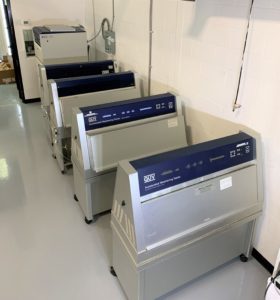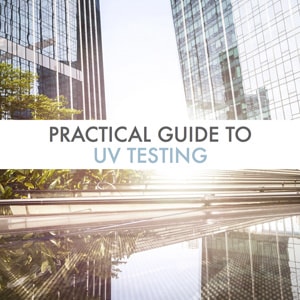ASTM D4799
Standard Practice for Accelerated Weathering Test Conditions and Procedures for Bituminous Materials (Fluorescent UV, Water Spray, and Condensation Method)
ASTM D4799 testing is now offered by Micom as part of its UV testing and material testing services. ASTM D4799 —Accelerated weathering test conditions and procedures for bituminous materials (fluorescent UV, water spray, and condensation method)—describes the procedure and the test conditions required for the assessment of the weathering characteristic of bituminous roofing and waterproofing materials. This standard uses UVA lamps as an illuminating source, and it is thus based on the ASTM G154 and the ISO 4892-3 practices.
Accelerated weathering for bituminous materials—use and factor to consider:

The main factor that has to be considered when running this test is: the time of exposure.
Typical Experimental parameters for ASTM D4799 testing:
The number of samples required is three when this test is executed in conjuncture with a non-destructive test protocol, but if the following method is destructive, the number of specimens needed is six. The size of the sample is 3 by 6 in (75 by 150 mm) and a control specimen has to be tested alongside the sample. The specifications of the test cycles are listed in table 1, and the experiment parameters are detailed in table 2.
Table I: Typical test cycles parameters
| Test cycles | Specifications |
| Cycle A | 4h UV exposure at 60 ± 2.5 °C 4h condensation at 50 ± 2.5 °C |
| Cycle B | 20h UV exposure at 60 ± 2.5 °C 4h condensation at 50 ± 2.5 °C |
| Cycle C | 20h UV exposure at 80 ± 2.5 °C 4h condensation at 50 ± 2.5 °C |
| Cycle D | 4h UV exposure at 60 ± 2.5 °C 15 mins water spray 3.75h condensation at 50 ± 2.5 °C |
| Cycle E | 20h UV exposure at 60 ± 2.5 °C 15 mins water spray 3.75h condensation at 50 ± 2.5 °C |
| Cycle F | 20h UV exposure at 80 ± 2.5 °C 15 mins water spray 3.75h condensation at 50 ± 2.5 °C |
Table II: Typical test parameters
| Parameters | Specifications |
| Lamp type | UVA-340 |
| Irradiance level | 0.89 ± 0.02 W/(m2nm) at 340 nm |
| Exposure time | Has to be specified |
If you have any questions about the ASTM D4799 test, we invite you to contact our material testing lab today. It will be our pleasure to answer your questions and help you with your custom material testing requirements.
Practical UV Testing Guide
Sunlight exposure can have harmful impacts on carbon-based
materials such as coatings, polymers, textiles, and many others.
Learn more about our in-laboratory UV testing process in this guide.


